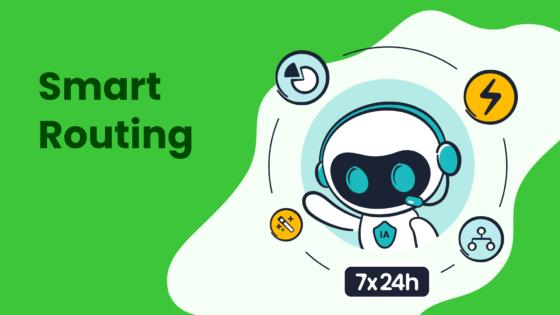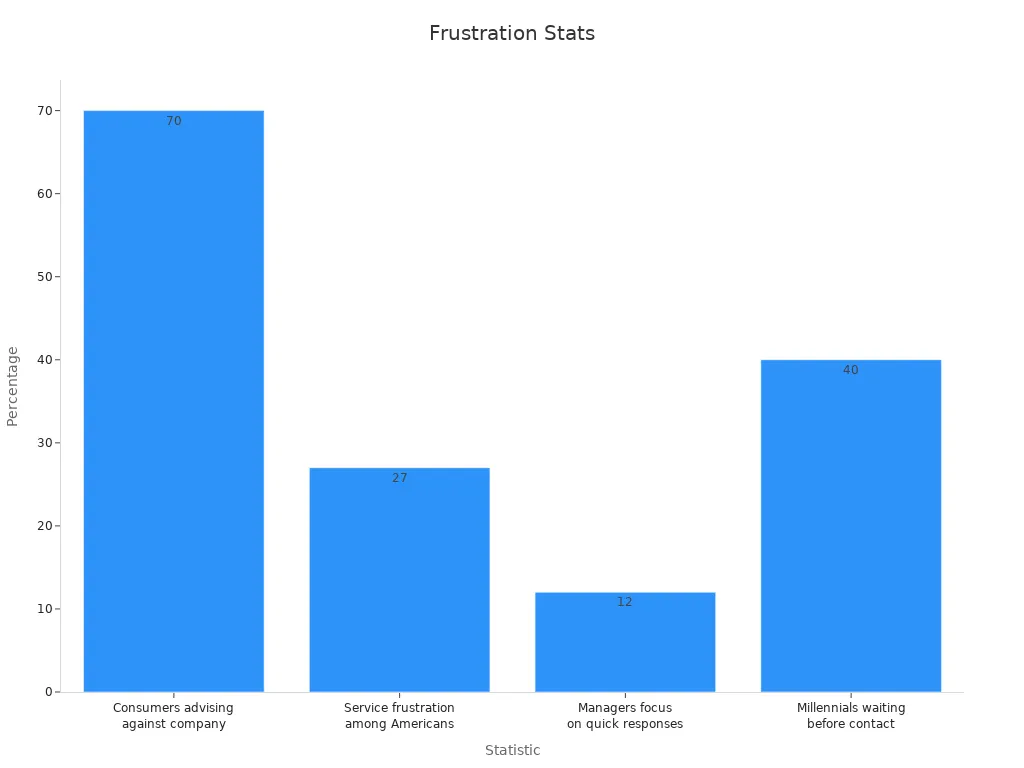Real-Life Customer Service Problems and Fixes for 2025

Customer service in 2025 is no longer just about solving problems. It’s about meeting rising expectations and delivering experiences that feel personal and seamless. Did you know US companies lose $75 billion yearly due to poor customer service? Customers now expect faster responses, smarter solutions, and empathy at every touchpoint. Businesses that embrace tools like Sobot’s innovative solutions can stay ahead by analyzing customer needs and creating hyper-personalized experiences. In this fast-paced world, addressing customer service issues isn’t optional—it’s essential for growth.
Understanding Bad Customer Service in 2025
Defining Customer Service Issues
Customer service issues in 2025 go beyond just long wait times or unresolved problems. They include a wide range of challenges that frustrate customers and hurt businesses. For example, inconsistent information across channels, robotic interactions, and lack of empathy are common complaints. These issues often stem from outdated systems, untrained staff, or a failure to adapt to modern expectations.
A recent study highlights how bad customer service affects people. Did you know 32% of consumers find phone calls the most frustrating channel? Or that 75% of people hang up if they’re on hold for more than 10 minutes? These numbers show how critical it is to address these problems.

The Impact of Poor Customer Service on Business Growth
Bad customer service doesn’t just annoy customers—it can destroy your business. When customers feel ignored or mistreated, they leave. Worse, they tell others about their bad experiences. This creates a ripple effect that damages your reputation and reduces revenue.
Here’s how poor customer service impacts growth:
- Customers lose trust and switch to competitors.
- Negative reviews scare away potential buyers.
- You spend more money trying to replace lost customers.
- Employee morale drops because of constant complaints.
Think about it: 65% of consumers have cut ties with a brand after just one bad experience. That’s a huge loss for any business. Fixing these issues isn’t just about keeping customers happy—it’s about survival.
Why Customer Expectations Are Higher Than Ever
Today’s customers expect more than ever before. They want fast, personalized, and seamless service. If you don’t deliver, they’ll move on. Technology plays a big role here. With so much information at their fingertips, customers know what great service looks like—and they demand it.
Here are some key stats:
- 72% of customers want immediate service.
- 70% expect agents to have full context of their history.
- 48% believe loyal customers deserve special treatment.
Meeting these expectations isn’t easy, but it’s necessary. By understanding what customers want and using tools like Sobot’s omnichannel solutions, you can stay ahead and create a better customer experience.
Example 1: Long Wait Times for Customer Support

The Problem: Frustration with Delayed Responses
Long wait times are one of the most common causes of bad customer service. Imagine calling a support line, only to be stuck on hold for what feels like forever. It’s frustrating, right? You’re not alone. Studies show that 27% of Americans rank ineffective service as their top frustration, and 70% of consumers will warn others against a company after a bad experience.
The problem doesn’t stop there. Millennials, for example, are particularly impatient. About 40% will wait no more than 60 minutes before trying another channel. This leads to fragmented communication and more customer complaints. Businesses that fail to address this issue risk losing customers and damaging their reputation.
Here’s a closer look at how delayed responses affect customer satisfaction:
| Metric | Observation |
|---|---|
| CSAT Score | A score of 85% may mask complaints about slow delivery times. |
| AI Sentiment Analysis | Detected negative sentiment related to unresponsive customer support. |
| Customer Complaints | A measurable drop in complaints after implementing changes. |
| Customer Satisfaction | Increased satisfaction following proactive measures to address wait times. |


The Fix: Leveraging Sobot’s Voice/Call Center for Smart Call Routing
So, how do you fix this? The answer lies in smarter technology. Sobot’s Voice/Call Center is designed to tackle this problem head-on. Its smart call routing feature ensures that every call reaches the right agent quickly. No more endless transfers or wasted time.
With Sobot, you can also take advantage of its AI-powered Voicebot, which handles simple queries instantly. This frees up your agents to focus on more complex issues. The result? Faster responses and happier customers. In fact, businesses using Sobot have seen customer satisfaction rates soar to 97%.
Here’s what makes Sobot’s solution stand out:
- Smart Call Routing: Automatically directs calls to the best-suited agent.
- Unified Workspace: Gives agents all the tools they need in one place.
- Real-Time Monitoring: Tracks performance and identifies bottlenecks.
By implementing Sobot, you’re not just solving a problem—you’re transforming the customer service experience. Your customers will notice the difference, and so will your bottom line.
Example 2: Lack of Empathy in Customer Interactions
The Problem: Robotic or Uncaring Service Experiences
Have you ever spoken to a customer service agent who sounded like a robot? It’s frustrating, right? A lack of empathy in customer interactions is one of the most common examples of bad customer service. Customers want to feel heard and understood, but robotic or uncaring responses can make them feel ignored. This problem often arises when agents focus too much on scripts or fail to connect emotionally with the person on the other end.
Here’s the thing: emotions play a huge role in customer satisfaction. When agents don’t show empathy, it can lead to more customer complaints and even damage your brand’s reputation. For example, UX researchers have observed that focusing too much on one customer’s frustration can lead to solutions that create friction for others. Emotional responses to individual stories can overshadow data-driven decisions, causing projects to continue despite evidence to the contrary.
This kind of poor customer service doesn’t just hurt the customer experience—it also impacts your bottom line. Customers who feel undervalued are more likely to leave negative reviews or switch to competitors.
The Fix: Training Representatives in Emotional Intelligence and Active Listening
So, how do you fix this? The answer lies in emotional intelligence (EI) and active listening. Training your team in these skills can transform your customer service experience. Emotional intelligence helps agents recognize and respond to customer emotions, while active listening ensures they truly understand the problem.
Companies that invest in EI training see incredible results. For instance:
- Productivity increases by 36% for top performers.
- Employee engagement scores rise by 25% within six months.
- Turnover rates drop by 15%, saving costs on hiring and training.
Additionally, organizations focusing on EI training report a 32% boost in customer satisfaction and a 47% increase in workplace collaboration. These improvements directly enhance the customer experience, reducing bad interactions and improving first-call resolution rates.
Sobot’s unified workspace can further support this transformation. By giving agents access to complete customer histories, they can personalize interactions and respond with empathy. When paired with emotional intelligence training, tools like Sobot’s omnichannel solution create a seamless and caring customer service experience.
Empathy isn’t just a nice-to-have—it’s essential for building trust and loyalty. Start training your team today, and you’ll see the difference in happier customers and fewer complaints.
Example 3: Inconsistent Information Across Channels
The Problem: Confusion from Conflicting Answers
Have you ever contacted a company through email, only to get a completely different answer when you called their support line? It’s frustrating, isn’t it? This kind of bad customer service happens when businesses fail to provide consistent information across their channels. Customers feel confused, and trust in the brand takes a hit.
Here’s the reality: only 26% of organizations offer a fully connected user experience across all channels. That means most businesses struggle to deliver clear and unified answers. Three-quarters of companies also find it hard to integrate data insights into their customer experience. This lack of integration leads to conflicting responses, leaving customers feeling lost and unsupported.
Nicole Greene, a VP analyst at Gartner, highlights the importance of effective data sharing. She suggests that customer experience, marketing, and business leaders should collaborate with IT teams to fix these issues. Without this teamwork, businesses risk creating a fragmented customer service experience that drives customers away.
The Fix: Implementing Sobot’s Omnichannel Solution for Unified Communication
So, how do you solve this problem? The answer lies in unifying your communication channels. Sobot’s Omnichannel Solution is designed to eliminate inconsistencies by integrating all your customer service platforms into one seamless system.
Here’s how it works:
- Unified Workspace: Agents can access all customer interactions—whether they’re from email, chat, or social media—in one place. This ensures they always have the full context.
- AI-Driven Insights: Sobot uses AI to analyze customer data, helping agents provide accurate and personalized responses.
- Self-Service Options: Customers can resolve 22.2% of their questions on their own, reducing the need for repetitive inquiries.
The results speak for themselves:
| Improvement Type | Metric |
|---|---|
| Customer satisfaction rate | 96% positive feedback |
| Correct answers provided | Over 80% |
| Overall customer satisfaction score | 97% CSAT score |
| Problem-solving efficiency | 85% of problems solved |
By implementing Sobot’s solution, you can reduce confusion and create a smoother customer experience. Customers will notice the difference when they receive consistent, accurate answers every time they reach out. Plus, your team will work more efficiently, solving problems faster and keeping customers happy.
When you unify your communication channels, you’re not just fixing bad customer service—you’re building trust and loyalty. That’s the kind of customer service experience that keeps people coming back.
Example 4: Failure to Resolve Issues on First Contact
The Problem: Repeated Follow-Ups and Customer Frustration
Imagine reaching out to a company for help, only to find yourself explaining the same issue over and over. Frustrating, right? This is one of the most common examples of bad customer service. When problems aren’t resolved on the first contact, customers feel ignored and undervalued. It’s not just annoying—it’s a major reason why people stop doing business with a brand.
Studies show that 33% of customers say they’d consider switching companies after just one bad experience. Repeated follow-ups make things worse. Customers lose trust, and your team wastes time handling the same issue multiple times. This creates a ripple effect, lowering satisfaction scores and increasing churn rates.
The root of this problem often lies in poor communication and a lack of agent empowerment. When agents don’t have the tools or authority to resolve issues quickly, the customer experience suffers.
The Fix: Empowering Agents with Decision-Making Authority Using Sobot’s Unified Workspace
You can fix this by giving your agents the power to solve problems on the spot. Sobot’s Unified Workspace is designed to make this easy. It brings all customer data, interaction history, and tools into one place. This means agents have everything they need to provide fast, accurate responses.
Here’s how Sobot helps:
- Comprehensive Customer View: Agents can see the full history of interactions, so they don’t ask customers to repeat themselves.
- Decision-Making Tools: With access to real-time data and AI-driven insights, agents can make informed decisions without waiting for approvals.
- Streamlined Workflows: Sobot automates repetitive tasks, freeing up agents to focus on resolving complex issues.
Businesses using Sobot report a 40% increase in first-contact resolution rates. This not only reduces customer frustration but also boosts loyalty. When customers see that you value their time, they’re more likely to stick around.
Empowering your team isn’t just about solving problems faster—it’s about creating a better customer experience. With Sobot, you can turn bad customer service into a thing of the past.
Example 5: Ignoring Customer Feedback

The Problem: Customers Feeling Unheard
Have you ever shared feedback with a company, only to feel like it went straight into a black hole? You’re not alone. A survey found that 53% of customers believe companies don’t act on the feedback they provide. This creates a perception that their voices don’t matter. When customers feel unheard, they lose trust and are more likely to take their business elsewhere.
Ignoring customer feedback can lead to serious consequences for your business. Here’s a quick breakdown:
| Consequence | Description |
|---|---|
| High customer churn | Dissatisfied customers leave, impacting revenue. |
| Stagnant engagement | Customers stop interacting with your brand, reducing loyalty. |
| Worsening customer experience | Unaddressed concerns push customers toward competitors. |
| Damaged reputation | Negative reviews spread, harming trust and credibility. |
| Missed opportunities for improvement | Valuable insights for innovation and growth are lost. |
When feedback is ignored, it’s not just bad for customers—it’s bad for your business. The customer journey becomes frustrating, and your reputation takes a hit.
The Fix: Actively Collecting Feedback and Using Sobot’s Analytics Tools for Transparency
The solution? Start listening to your customers and acting on their feedback. Sobot’s analytics tools make this easier than ever. With real-time reporting and sentiment analysis, you can track what your customers are saying and identify areas for improvement.
Here’s how Sobot helps:
- Real-time analytics and reporting: Monitor key performance indicators and understand customer behavior instantly.
- Sentiment analysis: Detect customer emotions during interactions and prioritize urgent cases.
By using these tools, you can turn feedback into actionable insights. For example, if customers frequently mention slow response times, you can adjust your processes to address this issue. Businesses that actively collect and act on feedback see higher satisfaction rates and stronger loyalty.
Listening to your customers isn’t just about fixing problems—it’s about building trust. When customers see that you value their input, they’re more likely to stick around and recommend your brand to others. With Sobot, you can create a transparent and responsive customer experience that sets you apart from the competition.
Bad customer service isn’t just a problem—it’s a roadblock to growth. Fixing these issues helps you build trust, improve loyalty, and create a better experience for your customers. Modern solutions like Sobot’s tools make this easier than ever.
Sobot’s products, from smart call routing to omnichannel communication, empower you to meet customer expectations head-on. They simplify workflows, boost satisfaction, and help you stay ahead in a competitive market.
Your customers deserve the best. Start improving your service today with Sobot! 🚀
FAQ
What makes Sobot different from other customer service tools?
Sobot stands out with its all-in-one platform. It combines AI-powered automation, omnichannel communication, and real-time analytics. You get tools like smart call routing, unified workspaces, and sentiment analysis—all designed to improve efficiency and customer satisfaction. Plus, it’s scalable for businesses of any size.
Can Sobot integrate with my existing systems?
Yes! Sobot integrates seamlessly with popular CRMs like Salesforce and Shopify. It also works with other technology management systems. This ensures your team can access all customer data in one place, making workflows smoother and more efficient.
How does Sobot improve first-contact resolution rates?
Sobot empowers agents with a unified workspace. They can view complete customer histories and use AI-driven insights to make quick decisions. This reduces the need for follow-ups and ensures most issues get resolved on the first contact, boosting customer satisfaction.
Is Sobot suitable for small businesses?
Absolutely! Sobot’s solutions are flexible and cost-effective. Small businesses benefit from features like batch outbound calling, AI-powered chatbots, and WhatsApp API. These tools help you deliver professional customer service without breaking the bank.
How secure is Sobot’s platform?
Sobot prioritizes security. It uses encrypted data transfer and ensures a 99.99% system uptime. With global network support and compliance with data privacy regulations, you can trust Sobot to keep your customer interactions safe and reliable.
See Also
Transforming Support With Innovative AI Customer Service Agents
2024's Leading Customer Service Software: Our Top 10 Picks
Explore 2024's Best Voice of Customer Software Solutions
Comprehensive Reviews of 2024's Best Contact Center Solutions
